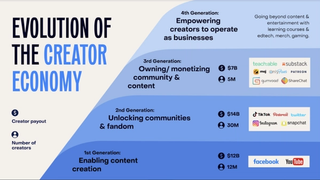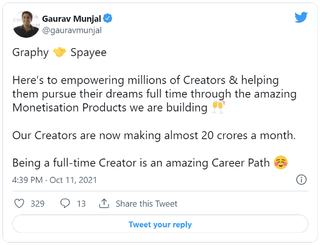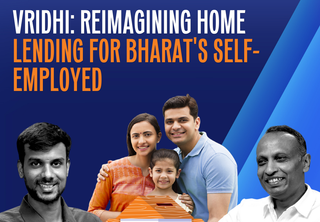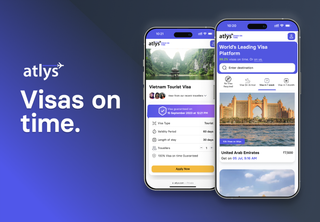Evolution of the Creator Economy - what's next
Four stages in the evolution of the creator economy
Social platforms today have become like movie theaters. You go to them for content but the decision to visit them in the first place depends on the quality of the films available. And just like in a theater, if you don’t have the content that people like, they will just go to another one which does.
Most content consumers today follow niche creators across various interest types. While most users earlier would go to a platform such as YouTube / Instagram / Twitter and search for their topics of interest, today several users tend to search for specific creators who make content on topics they want to consume more of.
Rise of the social media-enabled individual business
The modern economy was built around corporations and companies. Land/Infrastructure, labour, capital and entrepreneurship formed the 4 factors of production which enabled the creation of large enterprises that fueled an economy built on the production of goods and services. However, over the last couple of decades, the advent of the internet and smartphones has led to a democratization that has enabled individuals to operate as businesses in themselves - leading to paradigm shifting economic models. Media platforms, creation tools, distribution platforms API/payment integrations have provided individuals an opportunity to nurture a digital identity, build social communities and monetize them. As we look ahead, a new economy is coming into the foray, where individual creators will gain prominence and be indispensable for platforms to retain viewers. In this model, creators will provide entrepreneurship and labor. The advent of tools, infrastructure and financial products focused on creators will provide the rest.
Evolution of the creator economy : From enabling content creation to operating as businesses

1st generation social/content platforms allowed creators to generate and distribute content at scale. Here monetization was limited to a share of the advertising revenue. With the 2nd generation, creators were empowered with tools to help with content creation, build and engage with communities but monetization avenues remained limited mainly to brand collaborations. The third generation of creator platforms unlocked multi-format content creation and more personalized engagement than ever before. New streams of monetization were unlocked. With every new generation of platforms, there has been an evolution in the content format, mode of creation, creator demographic, creator tools, engagement and monetization stream, all leading to the creation of a deeper market for creators to tap into. During this journey of social media and creator platforms over the past decade, the following were some of the key evolutions that took place:
1. Creation has been democratized: The mode of content creation has gone from expensive devices like desktop, professional cameras etc to affordable mobile phones with at-home set-ups. This has enabled young people who don’t necessarily have access to a large amount of capital to invest in equipment, to create high quality content. For ex: Bhuvan Bam, a Youtuber who started out as a 22 year old by making comic videos through his channel BB Ki Vines in 2015, now has 25M subscribers on YouTube and an estimated net worth of $4M.
Another trend that has come about is that influencers are tapping into a wide range of niches beyond entertainment and curating large communities in specific verticals. For example, Motivational speaker Sandeep Maheswari has 23M subscribers on YouTube. Gaurav Chaudhary (aka Technical Guruji), who covers gadget reviews and does tech explainers has 22M subscribers on YouTube. Nisha Madhulika who runs a cooking channel on YouTube has 13M subscribers.
2. Platforms have become creator first: While platforms like YouTube were mainly focused on improving discovery and consumption of content by the end consumer, platforms like Dubsmash, TikTok, Instagram started by focusing on creators by introducing tools like filters and music layers that allowed creation of engaging and innovative content. The next generation of platforms such as Patreon, Teachable, Onlyfans, Gumroad took this a step further by enabling monetization through subscriptions, courses and merchandising and improving business productivity through CRM, marketing tools and payment integrations. Streamloots is providing gamified tools that let mid and end-tail of e-sports creators monetize their superfans by delivering personalized engagement. Superfans can pay to decide what costume a creator wears or what weapons they use in a game. Platforms like Circle.so let creators own their audience in the true sense by allowing creators to white label their communities and integrate with their personal websites.
More recently, Facebook and Tiktok have even launched their own creator funds and earmarked $1.2B+ to help creators kickstart their journey and grow.
3. Ownership of the end consumer has moved from platforms to creators: Followers have developed loyalty towards creators rather than to platforms. They follow the same creator(s) across multiple platforms like Facebook, Instagram, YouTube, TikTok etc. Earlier tools like ad managers and analytics tools were made specifically for individual platforms but now tools like Linktree that integrate a creator’s social capital and following across multiple platforms and monetize them have taken off. Within 6 years of launch, Linktree accounts for 24M creators (out of the 45 Mn creators with >10K followers) and is growing faster than ever before. In the web3 world, there are platforms helping creators launch their own social tokens which could be used on third-party apps where the underlying currency will be the creator’s coins and give fans access to special privileges, share in creator’s income, among other use-cases.
4. Expansion of monetization streams: Until very recently monetization avenues were limited to ad share (1st generation) and brand collaborations (2nd generation). The introduction of virtual gifting, services, courses, merchandising, affiliate commerce and shoutouts have unlocked new monetization streams that have significantly increased income per creator. Earnings/creator have increased to 1.5-3x ($1.4k/creator) on the 3rd generation platforms when compared to 1st and 2nd. In 2020, Patreon paid out $1B to creators averaging $5.5k/creator. Teachable also had a similar payout/creator, having paid out $500M. Onlyfans delivered $1.6B in creator earnings. On Substack, top 10 creators made $2M on an average in 2021.
Top 1% creators on Teachable earn $2.5M/year on avg, top 10% earn $300k/year. There have been outlier instances as well, where creators even earned six figure incomes within a day of launching their services

Even in India, platforms like Graphy and Spayee have empowered individuals to pursue being a creator as a full time career path

What the future holds and builders of the future blocks
Now that content creation and community engagement have been democratized and multiple avenues of monetization have been unlocked at scale, creators have started to operate as professional businesses. We believe that we are on the cusp of the next generation of creator platforms and tools that will cater to the needs of this new wave of social media-enabled creator businesses. These platforms and tools will lay the fundamental blocks on which the creator-driven economy will be built.
Our team
Our team comprises Amit Aggarwal, Vaas Bhaskar, Pranjal Agarwal, Utkarsh Bajpai and Ansh Aggarwal who have a deep understanding and strong conviction on the creator economy. We’d love to hear from you, if you too resonate with our conviction in the creator economy and are building or even thinking of building in the space. Please reach out to us for a chat at ansh@elevationcapital.com or utkarsh@elevationcapital.com.
Related

Harnessing Better Experience And Innovative GTM: Marketplaces Unleashed Part 3
Exploring the last two pillars of our marketplaces framework through case studies
03.08.2023

Vridhi: Reimagining Home Lending For Bharat's Self-Employed
Ram Naresh Sunku, Co-founder, Vridhi Home Finance
11.12.2024

Investing in Atlys
Building the world’s largest digital visa provider
21.09.2023